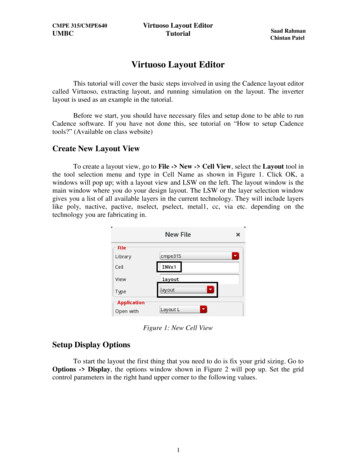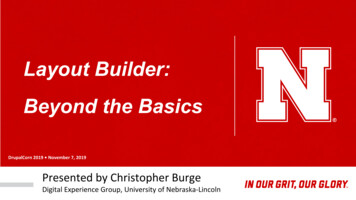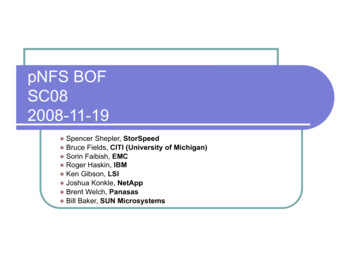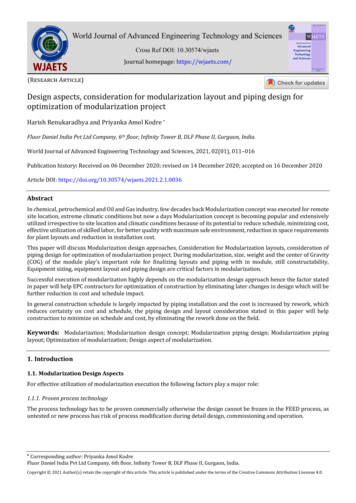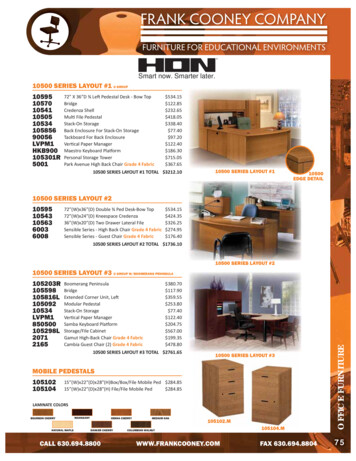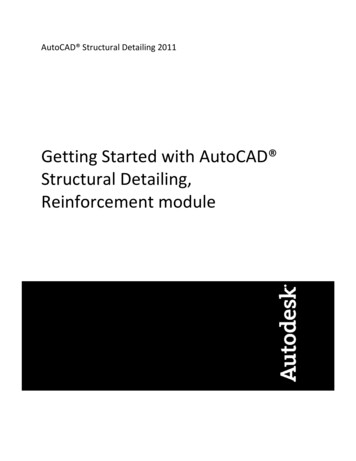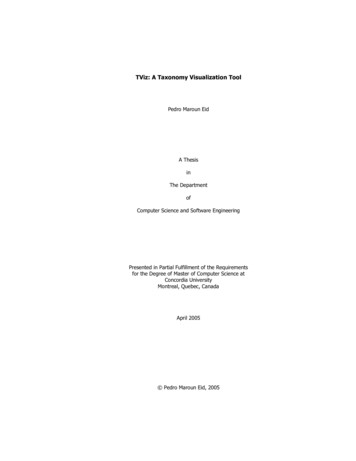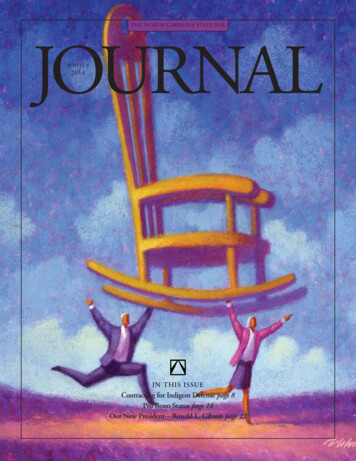
Transcription
THE NORTH CAROLINA STATE BARJOURNALWINTER2014IN THIS ISSUEContracting for Indigent Defense page 8Pro Bono Status page 14Our New President—Ronald L. Gibson page 22
Hanging on bya thread?You are not alone. Free, confidentialassistance is available.The Lawyer Assistance Program (“LAP”) wascreated by lawyers for lawyers. The LAP hasbeen a trusted resource for thousands of lawyers,judges, and law studentssince 1979. We arecommitted to helping youget the help you need.Every call or email we takeis confidential and isreceived by a professionalstaff person.Contact us NTIALWestern RegionPiedmont RegionEastern RegionCathy Killian 704.910.2310Towanda Garner 919.719.9290Nicole Ellington 919.719.9267
THENORTH CAROLINASTATE BARJOURNALWinter 2014Volume 19, Number 4FE AT U R E SEditorJennifer R. Duncan8Publications CommitteeG. Gray Wilson, ChairDorothy Bernholz, Vice-ChairJohn A. BowmanW. Edward BunchHarry B. CrowMargaret H. DicksonRebecca Eggers-GryderForrest A. FerrellJohn GehringDouglas R. GillJames W. HallAnna HamrickDarrin D. JordanSonya C. McGrawRobert MontgomeryNancy Black NorelliHarold (Butch) PopeAlan D. Woodlief Jr. Copyright 2014 by the North Carolina State Bar. Allrights reserved. Periodicals postage paid at Raleigh, NC,and additional offices. Opinions expressed by contributorsare not necessarily those of the North Carolina State Bar.POSTMASTER: Send address changes to the NorthCarolina State Bar, PO Box 25908, Raleigh, NC 27611.The North Carolina Bar Journal invites the submission ofunsolicited, original articles, essays, and book reviews.Submissions may be made by mail or e-mail (ncbar@bellsouth.net) to the editor. Publishing and editorial decisionsare based on the Publications Committee’s and the editor’sjudgment of the quality of the writing, the timeliness ofthe article, and the potential interest to the readers of theJournal. The Journal reserves the right to edit all manuscripts. The North Carolina State Bar Journal (ISSN10928626) is published four times per year in March,June, September, and December under the direction andsupervision of the council of the North Carolina State Bar,PO Box 25908, Raleigh, NC 27611. Member rate of 6.00 per year is included in dues. Nonmember rates 10.78 per year. Single copies 3.21. The Lawyer’sHandbook 10.78. Advertising rates available uponrequest. Direct inquiries to Director of Communications,the North Carolina State Bar, PO Box 25908, Raleigh,North Carolina 27611, tel. (919) 828-4620.www.ncbar.govT H E N O RT H C A RO L I N A S TAT E B A R J O U R N A LContracting for Indigent Defense:The Plan and the RealityBy Thomas K. Maher and Tucker Charns12 As North Carolina’s Needs Evolve,So Does its School of GovernmentBy Gini Hamilton14 Pro Bono Status: Staying Activein the Profession in RetirementBy Mary Irvine18 Legal Ethics Lessons from thePenn State ScandalBy Chris McLaughlin22 An Interview with New PresidentRonald L. Gibson23 Remarks from the President26 A Carolina Blue Bikini and aCourt-MartialBy Christopher GeisUpdate Membership Information: Members who need to update their membershipinformation must do so by contacting the Membership Department via one of the fourfollowing methods: (1) log on to the Member Access section of the State Bar’s website(www.ncbar.gov); (2) mail changes to: NC State Bar, Membership Dept., PO Box 26088,Raleigh, NC 27611-5908; (3) call (919) 828-4620; or (4) send an e-mail to amaner@ncbar.gov. In deciding what address to list with the State Bar, be advised that thisaddress will be used for all official correspondence from the State Bar and that membership information is a public record pursuant to the NC Public Records Act.3
D E PA RT M E N TS414253234363840State Bar OutlookIOLTA UpdateTrust AccountingLawyer Assistance ProgramLegal EthicsProfile in Specialization45The Disciplinary DepartmentRule AmendmentsProposed Ethics Opinions55565758B A R3954U P D AT E SIn MemoriamClient Security Fund606364State Bar Swears in New OfficersResolution of AppreciationFifty-Year Lawyers HonoredLaw School BriefsAnnual Reports of State Bar Boards2015 AppointmentsFebruary Bar Exam ApplicantsOfficersRonald L. Gibson, Charlotte - President 2014-2015Margaret M. Hunt, Brevard - President-Elect 2014-2015Mark W. Merritt, Charlotte - Vice-President 2014-2015L. Thomas Lunsford II, Raleigh - Secretary-TreasurerRonald G. Baker Sr., Kitty Hawk - Past-President 2014-201524:25:26:CouncilorsBy Judicial District1:C. Everett Thompson, Elizabeth City2:G. Thomas Davis Jr., Swan Quarter3A:Charles R. Hardee, Greenville3B:Debra L. Massie, Beaufort4:Robert W. Detwiler, Jacksonville5:Harold L. Pollock, Burgaw6A:Melissa Pelfrey, Littleton6B:Lloyd C. Smith Jr., Windsor7:Randall B. Pridgen, Rocky Mount8:Shelby D. Benton, Goldsboro9:Paul J. Stainback, Henderson9A:Alan S. Hicks, Roxboro10:Heidi C. Bloom, RaleighNicholas J. Dombalis II, RaleighTheodore C. Edwards II, RaleighJohn N. (Nick) Fountain, RaleighDonna R. Rascoe, RaleighJohn M. Silverstein, RaleighC. Colon Willoughby Jr., RaleighCynthia L. Wittmer, Raleigh11A:Donald E. Harrop Jr., Dunn11B:Marcia H. Armstrong, Smithfield12:Lonnie M. Player Jr., Fayetteville13:Harold G. Pope, Whiteville14:John A. Bowman, DurhamWilliam S. Mills, Durham15A:Charles E. Davis, Mebane15B:Dorothy Bernholz, Chapel Hill16A:William R. Purcell II, Laurinburg16B:David F. Branch Jr., Lumberton17A:Matthew W. Smith, Eden17B:Thomas W. Anderson, Pilot Mountain18:Barbara R. Christy, GreensboroRobert C. Cone, Greensboro18H:Richard S. Towers, High Point19A:James D. Foster, Concord19B:W. Edward Bunch, Asheboro19C:Darrin D. Jordan, Salisbury19D:Douglas R. Gill, Southern Pines20A:Frederick D. Poisson Jr., Wadesboro20B:Harry B. Crow Jr., Monroe21:Michael L Robinson, Winston-SalemG. Gray Wilson, Winston-Salem22:Kimberly S. Taylor, Taylorsville22B:Roger S. Tripp, Lexington23:John S. Willardson, Wilkesboro427A:27B:28:29A:29B:30:Rebecca Eggers-Gryder, BooneForrest A. Ferrell, HickoryRobert J. Bernhardt, CharlotteA. Todd Brown, CharlotteMark Henriques, CharlotteF. Fincher Jarrell, CharlotteDewitt McCarley, CharlotteNancy Black Norelli, CharlotteSonya Campbell McGraw, GastoniaRalph W. Meekins, LincolntonHoward L. Gum, AshevilleMarvin R. Sparrow, RutherfordtonChristopher S. Stepp, HendersonvilleGerald R. Collins Jr., MurphyPublic MembersMargaret H. Dickson, FayettevillePaul L. Fulton, Winston-SalemJames W. Hall, AhoskieStaffCarmen H. Bannon, Deputy CounselBetsy C. Barham, ReceptionistTim Batchelor, InvestigatorKelly Beck, Compliance Coordinator, Membership/CLEJoy C. Belk, Asst. Dir. Paralegal CertificationKrista Bennett, Fee Dispute Facilitator, ACAPMichael D. Blan, Systems Analyst/ProgrammerPeter Bolac, District Bar Liaison/Trust Account ComplianceCounselElizabeth E. Bolton, ReceptionistLori Brooks, Admin. Asst., Office of CounselDelia M. Brown, Administrative Asst., LAPKrista E. Carlson, InvestigatorBecky B. Carroll, ParalegalJoseph D. Cerone, Office ManagerAlyssa M. Chen, Deputy CounselMargaret Cloutier, Senior Deputy CounselJoseph J. Commisso, Director of InvestigationsSusannah B. Cox, Deputy CounselLuella C. Crane, Director of ACAPJennifer R. Duncan, Director of CommunicationsA. Root Edmonson, Deputy CounselJulie A. Ferrer, CLE ClerkMartha Fletcher, Payroll and Benefits AdministratorTowanda Garner, Piedmont LAP CoordinatorLanice Heidbrink, Exec. Asst., AdministrationJeffery Hill, Computer Systems AdministratorLeanor Hodge, Deputy CounselDebra P. Holland, Asst. Director, CLEMary L. Irvine, Access to Justice CoordinatorTammy Jackson, Membership DirectorKatherine Jean, Counsel and Assistant Executive Dir.David R. Johnson, Deputy CounselSharon Kelly, Events ManagerBarbara Kerr, ArchivistCathy D. Killian, Clinical Director, LAPMelanie Kincaid, ParalegalSuzanne Lever, Asst. Ethics CounselL. Thomas Lunsford II, Executive DirectorAdam Maner, Professional Organization CoordinatorBeth McIntire, IT ManagerBeth McLamb, Payment Coordinator, MembershipNichole P. McLaughlin, Asst. Ethics CounselBarry S. McNeill, Deputy CounselDiane Melching, Admin. Asst., ACAPDottie K. Miani, Deputy Clerk of DHC/Asst. Facilities ManagerClaire U. Mills, Accounts Manager, IOLTAAlice Neece Mine, Asst. Executive Dir., Dir. of CLE,Specialization, & Paralegal CertificationRobynn E. Moraites, LAP DirectorGeorge Muench, InvestigatorDenise Mullen, Asst. Director of SpecializationPat Murphy, Deputy CounselLoriann Nicolicchia, Accreditation Coordinator, CLEEmily Oakes, Attendance/Compliance Coordinator, CLEBrian Oten, Deputy CounselLisanne Palacios, Accounting ManagerAnne M. Parkin, Field AuditorHeather Pattle, Administrator, Office of CounselC. Fred Patton Jr., InvestigatorWondella Payne, ParalegalAaliyah Pierce, Acct. Data Asst., IOLTAAngel Pitts, Mail/Copy/Accounting ClerkJennifer Porter, Deputy CounselEvelyn Pursley, Executive Dir., IOLTASonja B. Puryear, Admin. Asst., InvestigationsJoan Renken, Admin. Asst., Office of CounselRandall C. Ross, InvestigatorWhit Ruark, InvestigatorSandra L. Saxton, Public Liaison, ACAPFern Gunn Simeon, Deputy CounselJaya Singh, Accounting Asst.Jennifer Slattery, ParalegalSusie Taylor, Admin. Asst./Special Projects Manager, LAPJudith Treadwell, Public Liaison, ACAPKristina M. Troskey, ParalegalWayne C. Truax, InvestigatorJoshua T. Walthall, Deputy CounselA. Dawn Whaley, Admin. Asst., InvestigationsEdward R. White, InvestigatorBrittany A. Wilson, ParalegalMary D. Winstead, Deputy CounselChristiane Woods, Admin Asst., InvestigationsWINTER 2014
S TATEBA ROUTLOOKWe’ve Got the Magazines to Swing ItBYL. TH O MASLUN S F OR DIIIn the summer of 1977, after my second year of law school at Carolina, Igot a job as a law clerk with the NorthCarolina State Bar. There was reallynothing to recommend me for the positionbut, in the finest tradition of legal employment, I did have a friend whose father had apassing acquaintance with the man in charge,and that got me in the door. The job forwhich I applied didn’t actuallyexist when I arrived for myinterview. I just happened toshow up at a propitiousmoment. Earlier that year, theState Bar had received a smallfederal grant for some purpose that was never explainedto me, and it happened that asmall residual sum was liableto be returned if unused.Rather than send the moneyback to Washington, whichwould have violated the Codeof Financial Responsibility, a decision wasmade to hire me to do whatever it was thatreal law firms had law clerks do or, failing that,to go get coffee.As it turned out, it was a great break forme. The United States Supreme Court decided the case of Bates v. Arizona State Bar thatsummer, extending the protection of the FirstAmendment to lawyer advertising and foreverchanging the world of professional regulation.Because the licensed attorneys on the staffwere busy with disciplinary cases, it fell to meto analyze the Bates decision and to explain itsimplications for the agency going forward.Happily enough, the one skill I had acquiredin two years of law school—briefing reportedappellate cases—was sufficient, barely, for thetask. Not long after the decision came down,the State Bar Council met, and I found myselfreciting on the subject for the EthicsCommittee, telling preeminent lawyers likeFrank Spruill and Clifton Everett what itmeant, and being taken seriously. That experience and an additional measure of good forT H E N O RT H C A RO L I N A S TAT E B A R J O U R N A Ltune ultimately led to an offer of permanentemployment as a lawyer with the Bar, and I’vebeen fooling them ever since. Ironically, whatmany lawyers would describe as the worstthing to ever happen to the profession—theBates case—was the best thing that ever happened to me, professionally speaking.While the details of my story are unique,the broad outline of the narrative would notbe unfamiliar to most of mycontemporaries. That’s prettymuch how lots of aspiringlawyers came to be employedin those days. They went tolaw school immediately aftercollege. They scrounged somemeans of paying the modestcosts of tuition and subsistence. They learned how tothink, but not to do, aslawyers. They found legalwork as summer clerks. Theygraduated and picked upenough North Carolina law from RobinHinson to pass the bar exam. And then theylucked into readily available legal jobs thatpromised to complete their educations.The world of work, legally speaking, haschanged quite a lot since then, particularly fornewly-minted attorneys. These days novicesemerge from law school with much more debtand much less opportunity than we had fourdecades ago. The cost of legal education hasskyrocketed, far outstripping the rate of inflation, and has been financed increasingly bydebt that is easy to obtain but soul-crushinglydifficult to discharge. The high-paying jobsthat are necessary to service that kind of debtare increasingly rare. Indeed, since the recession began in 2007, legal employment of anysort has become much less available. In thecurrent economic environment, which mayrepresent the “new normal,” it appears thatonly about half of the freshest lawyers canexpect to be offered salaried employment thatrequires a law license in the year followingadmission to the Bar. The rest, including someof the best and the brightest, must either go italone or try another line of work. It’s that lastalternative that troubles me.Although most of the “seasoned” lawyers Iknow are in sympathy with the strugglingpeople being churned out by the law schools,they are also convinced that we already havemore than enough lawyers to go around. Thisopinion is shared with me quite frequently asI travel around the state, typically in the context of semi-rhetorical statement/questionslike, “We’ve got too many lawyers. When areyou people in Raleigh going to do somethingabout it?” At this point in such conversations,I generally mumble something about theSherman Act, the Dental Board case and treble damages, and blame the Board of LawExaminers, but in reality market forces are thereal determinants of how many lawyers wehave. I do understand the frustration of thosewho believe we are overlawyered. As more andmore suppliers of legal services compete to satisfy the existing demand, it gets harder andharder to make a decent living. Even worse,from the standpoint of those who regard thepractice of law as more than a business, theunbridled competition engendered by multiplying lawyers (and the Bates case), seems tocompromise professionalism. Many newlawyers without mentors or salaries are professionally isolated and can’t be effectively acculturated. Many older lawyers, who might haveonce been mentors, know only each other,and wonder whether they might be the last oftheir kind.I understand the concerns of those whoworry about there being too many lawyers,but tend to subscribe to the view that thegrowth of the profession is, on balance, a goodthing. To the extent that there is an oversupplyof attorneys, the market ought ultimately torespond and naturally restore some sort ofequilibrium. This may take a while since formany the decision to become a lawyer isalways going to be somewhat irrational. Iassume that for many people, law school is stillthe attractive path of least resistance—a nice5
warm place between college and the real worldthat seems to guarantee something like aninteresting and comfortable future. That fanciful notion was what animated me back in1975 when I applied. Others, no doubt, continue to buy into the appealing fantasies thatenliven courtroom dramas on television. Onewonders how law school applications mighthave been affected over the years if PerryMason, instead of flirting with Della Streetand embarrassing Lt. Tragg on cross-examination, had spent more time on camera responding to electronic discovery, filling out timesheets, or attending CLE courses, like reallawyers do.In any event, it seems to me that morelawyers are going to be needed during the nextquarter century, not fewer. In order to provideaccess to justice for a citizenry that is chronically underserved, more lawyers, or lawyerequivalents, are going to be necessary. In orderto fulfill the promise of the civil rights movement, we still need to expand minority participation in the profession significantly. And, inorder to regulate commerce and relationsamong people and countries in our increasingly populous, interconnected and fractiousworld, we’re going to have to have more andmore attorneys like us—well-trained NorthCarolinians with good sense and good will.My role and experience as the State Bar’sexecutive director for the past 23 years has alsoinclined me to suppose that the population oflicensed attorneys is likely to increase, and thatthat will be good for the profession—and selfregulation. After all, throughout my tenure,membership in the State Bar has grown inexorably and predictably. Over the past tenyears, for instance, we have experienced anaverage annual net increase in the number ofactive, dues-paying members of around 2.8%.This is of great importance since more than85% of the State Bar’s operational revenuecomes from dues. The profession’s steadygrowth in recent years has enabled us to service the membership, protect the public,expand programmatically, and otherwise doour duty without excessive deficit spending,without exhausting our cash reserves, andwithout having to petition the GeneralAssembly for authority to raise dues beyondthe current statutory maximum of 300—theamount at which dues have been set since2010. It has also allowed and encouraged thecouncil and its leadership to undertake theconstruction of our handsome new building—a structure intended to accommodate6the regulation of an expanding profession formany decades to come. Faith in this version ofthe future is what justified our borrowing 12,000,000 to finance most of the cost and,presumably, what convinced the bank tomake the loan.As things stand now, our operationalbudget is essentially balanced. That’s the outlook for 2015 as well. Looking forward, ourprojections tell us that even with the burden ofdramatically increased debt service, the StateBar ought to be able to operate effectively inthe current mode for at least the rest of thedecade without a dues increase. As you canimagine, these projections are founded upon avariety of questionable assumptions. Even so,they have in the past proven to be fairly reliable, possibly because, unlike most people, Ihave special insights that allow me to forecastinterest rates and a variety of other macroeconomic phenomena. Unfortunately, however,there are limits even to my clairvoyance. Thesedays that is particularly evident in regard tosuch things as health insurance costs and theexpenses associated with extraordinary litigation. Be that as it may, the cornerstone of myfinancial worldview here atop the northeastcorner of the intersection of Edenton andBlount Streets is the notion that I will be sending dues notices to more lawyers this year thanlast—at least 2.5% more—and that I will bedoing about that for many years to come.There are many reasons why that particular figure—2.5%—appeals to me. Perhapsmost significant is the fact that increases in thecost of living in this part of the country have,on average, been in that range for the past tenyears. Since the lion’s share of our budget—about 60%—is devoted to personnel cost,and since we strive to enable our employees toat least keep up with inflation, it’s nice to havea cash cow that gives at least that much moremilk each year. Because most of our othercosts are increasing at or below the rate ofinflation, the additional nourishment provided by about 684 new lawyers (2.5% of27,375) in 2015 ought to be just enough forus to break even in the coming year. Ofcourse, our economic equation is in reality abit more complicated than that. As the population of lawyers grows, it costs more to keepup with them. For instance, the number ofgrievances rises as a function of the increasingnumber of lawyers, and so does the cost ofrunning the disciplinary program. We alsopay for more—and pay more for—paperclips,postage, and magazines like the one you arecurrently devouring. Indeed, our experienceover the past 23 years is that despite incremental increases in membership and membershipfees, our revenues over time are gradually outstripped by our expenses. In the years immediately following a dues increase, we typicallyaccumulate surpluses that we consume in lateryears. This inevitably leads to the next duesincrease. The success of our financial management has been and probably will continue tobe measured by how long we can extend thesecycles.Anyway, the law schools in North Carolinaare still full and the pipeline of applicants tothe North Carolina State Bar is still gushing.Moreover, I am advised that the number offolks who hold licenses in other states and seekto gain admission to our Bar by comity andexamination is increasing every year. Despitethis rosy picture, from my point of view, it isworth noting that the number of applicants tolaw schools here and elsewhere is trendingdown. Should this phenomenon persist, mycash projections may have to be revised. Inthat regard, one must also be cognizant of thelegal profession’s “senior tsunami.” One of ourbiggest demographic cohorts looks frighteningly like me. Sixtyish, balding, and morethan a little squidgy around the edges.Although many of us will no doubt continueto pay dues into our dotage, if only to keepreceiving the Bar Journal, our ranks are alreadythinning. That kind of attrition really can’t begood for my successor’s budget.There is one other interesting developmentthat could affect the situation. At its meetingin October, the council approved for publication a new rule that would enable more people to qualify educationally to be admitted tothe State Bar. For the past 20 years or so, ourrule has provided that only those who havegraduated from law schools approved by theAmerican Bar Association can be admitted.That rule was predicated on the notion thatonly schools meeting the ABA’s elaborateaccreditation standards could be countedupon to assure the level of competence necessary to protect our state’s consumers of legalservices. In recent years, as new teachingmodalities and technologies have evolved, thisidea has come into question, and our leadership has come to admit the possibility thatunconventional legal education may be sufficient legal education. The proposed rule,which is set forth elsewhere in the magazine,essentially approves the legal educations ofgraduates who have been licensed in otherWINTER 2014
states for at least ten years and have remainedin good standing. Persons meeting those criteria and demonstrating the requisite characterand fitness to be a North Carolina lawyerwould be allowed to sit for our bar examination, despite the ABA’s refusal or inability toapprove their law schools. Interestingly, sincethe ABA doesn’t review foreign law schools atall, the proposed rule would for the first timealso provide a means by which qualifiedlawyers from outside the United States, whohave been admitted in other states, might gainadmission in our state.By extending “full faith and credit” to theaccreditation decisions of other states, wewould simply be substituting their judgmentsfor those of the ABA. There may be some riskin doing that, but it’s hard to say how much.We have a pretty good sense of the quality ofthe ABA’s decisions, and are not nearly asfamiliar with the judgments of our counterparts in Kansas and Montana. Be that as itmay, however, we ought to be able to assumetheir bona fides and, in any event, we can restassured that our Board of Law Examiners willquite literally put all such applicants to theT H E N O RT H C A RO L I N A S TAT E B A R J O U R N A Ltest. Only those whose legal educations aredemonstrably sufficient to pass our bar examination will be admitted. That filter, alongwith the satisfaction of all the other admissions requirements of two jurisdictions (oursand theirs), ought to ensure the minimumcompetence necessary to protect our citizens.And if the new rule helps sustain 2.5%growth, so much the better.I realize that the 2.5% figure may not havethe talismanic significance that I seem to beattributing to it. It’s just that in my exceptionally complicated world, it’s comforting to havea touchstone of some sort—a single unifyingidea that explains, rationalizes, and justifieswhat we’re doing, or want to do. In that connection, I’m reminded of one of my fictionalheroes, Floyd Lawson, the proprietor ofFloyd’s Barbershop on the old Andy GriffithShow. Floyd’s dream was to expand his business empire by a factor of two, doubling hisproductivity by taking on an associate andbecoming a “two-chair shop.” In contemplation of that momentous decision, he refusedto be distracted or confused by niggling detailsand gave no thought whatsoever to the possi-bility that his new hire might be more inclinedto illegal bookmaking than to leveling sideburns. Rather than get lost in the weeds, hechanneled his inner bar executive. He focusedon the one thing that would make or breakhim in a two-chair environment. He looked atthe table over in the corner, and declared withsupreme confidence, “We’ve got the magazines to swing it.” nL. Thomas Lunsford II is the executive director of the North Carolina State Bar.Please note: in the Fall 2014 edition of theJournal, reprinting of the article, “LifeAfter Meth—A Journey of Addiction andRecovery, by Wilson “Wil” Miller, wasauthorized by the Washington State BarAssociation and originally appeared in theJune 2014 issue of NYLawyer. Also, in theParalegal Certification column, PatriciaClapper is an adjunct professor at CentralCarolina Community College.7
Contracting for Indigent Defense:The Plan and the RealityBYTHO MASK. MAH ERAN DTUCKERCHA RNSBy 2011, North Carolinahad created an indigentdefense system thatconsistently providedquality representation at a surprisingly modest cost. Even with coun-sel receiving 75 per hour for noncapital cases, the average cost for anadult misdemeanor case was approximately 240, the average cost for iStockphoto.coman adult low-level felony case was approximately 435, and the aver-age cost for an adult high-level felony case was approximately 1,180.The success of indigent defense in North Carolina was due to the willingness of a large number of skilled lawyers to take appointed cases as partof their private practices, or to work full time in public defender offices.The General Assembly, faced with the fallout from the financial meltdown, was determined to reduce the amount spent on providing counsel for those who are too poor to hiretheir own lawyer, and who are constitutionally or statutorily entitled to court-appointedcounsel. First, IDS was required to reduce the8hourly rate paid to private counsel, puttingsignificant stress on the private-assignedcounsel system. Second, legislators grappledwith large scale, systemic changes to howindigent representation was delivered.Neither the House nor the Senate supportedthe existing local roster system. The budgetpassed by the House would have created astatewide system of public defenders, with thepublic defender districts consolidated so thatoffices would cover a larger number of counties. The Senate, however, favored contractswith private lawyers. Ultimately, the Senateview carried the day, and the final 2011 budgWINTER 2014
et required IDS to issue Requests forProposals (RFPs) for contracts to cover allcase types throughout the state.Creating a statewide system under whichIDS would issue RFPs for representation inall case types—and saving money in theprocess—presented significant challenges.Although IDS has used contracts with individual lawyers and a few nonprofits to provide representation in some areas and casetypes, those contracts were individually negotiated, covered a very small percentage of thecases, and were designed to be cost-neutralrather than to decrease spending. Contractsfor indigent defense in other jurisdictionshave often led to low-bid contracts with nosupport for quality representation, whichIDS wanted to avoid. The truth is that allindigent defense systems rely on some formof contract with the lawyer; public defenderswork pursuant to an employment contractunder which they are paid an annual salaryand agree to take all of the cases assigned tothem by their office, private-assigned counselimplicitly contract to provide representationon individual cases and accept payment forthe hours allowed by the judge at the end ofthe case, and other contracts pay counsel a setamount per case or to take a designated caseload. All of these systems present a potentialconflict between the desire to control costsand the constitutional imperative to providequality representation. Providing quality representation takes time, and reducing the costinvolves paying defense counsel less moneyfor the hours they work, forcing counsel tospend less time on each case, or identifyingefficiencies in a nonefficient court system. Increating a contract system, IDS was painfullyaware of the difficulty in balancing the pressure to reduce spending with the need to provide constitutionally effective representation.The difficulty of creating a viable system andgenerating savings was compounded by therecently reduced rates for private counsel.Those rates significantly cut into the actualearnings for lawyers who provide direct representation to clients, and are not sustainablefor the long term. Any contract system thatsignificantly reduced compensation beyondthese rates would ultimately lead to long-termproblems.The first steps in creating a contract system were to survey the systems that were inplace in other jurisdictions, and to determinethe characteristics of systems that fosteredquality representation and those that sacriT H E N O RT H C A RO L I N A S TAT E B A R J O U R N A Lficed the quality of representation for costsavings. Not surprisingly, there are a variety ofcontract m
58 Law School Briefs 60 Annual Reports of State Bar Boards 63 2015 Appointments 64 February Bar Exam Applicants Officers Ronald L. Gibson, Charlotte - President 2014-2015 Margaret M. Hunt, Brevard - President-Elect 2014-2015 Mark W. Merritt, Charlotte - Vice-President 2014-2015 L. Thomas Lunsford II, Raleigh - Secretary-Treasurer

